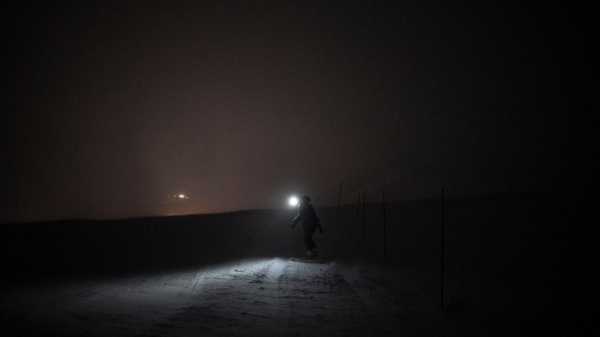
LONGYEARBYEN, Norway — The warm glow of Svalbard Kirke’s lights gleams on the mountain slope from where the church stands over this remote Norwegian Arctic village, cloaked in the polar night’s constant darkness.
A century after it was founded to minister to the coal miners who settled Longyearbyen, the Lutheran house of faith is open 24/7, serving as a beacon for the community navigating a drastic change in its identity.
The last Norwegian coal mine in Svalbard – an archipelago that’s one of the world’s fastest warming spots – was slated to close this year and only got a reprieve until 2025 because of the energy crisis driven by the war in Ukraine.
For the lone pastor, the challenge is to fulfill the church’s historical mission of ministering to those in crisis while addressing a pressing, divisive contemporary challenge.
“We pray every Sunday for everyone who’s affected by climate change,” the Rev. Siv Limstrand said.
Svalbard Kirke beckons to its fireplace-warmed lounge that opens into the sanctuary. A cup of coffee or hymnbooks in multiple languages are always available.
“You don’t have to be very religious. They have room for everybody,” said Leonard Snoeks, whose daughter sings in Polargospel, the church’s children’s choir, and whose wife is working on the city’s energy plan.
The switch this year from coal-fired to diesel-powered energy production at the plant – which prompted the mine’s decision to shut down – is expected to halve carbon dioxide emissions, said Torbjørn Grøtte, Longyearbyen’s energy transition project leader.
As change swirls faster than the snowdrifts outside, the church’s anchoring role seems poised to remain the only constant.
It attracts miners who have attended funerals for colleagues who died on the job over the decades, as well as newly arrived scientists and tourism workers seeking to integrate in the increasingly diverse community where people now tend to stay only a couple of years.
Store Norske, the Norwegian company still operating the remaining mine, built the first church in 1921 in Longyearbyen, which for most of the 20th century was inhabited by single miners and the mining executives’ families.
Trond Johansen was 17 when he arrived in 1971 on a plane chartered by the mining company. Sipping black coffee on a mid-January morning in the town’s sleek café, the retired miner recalled when the main entertainment was at the church.
Johansen and fellow miners gathered on Wednesdays to watch four-week-old videocassettes of news broadcasts from the mainland – though they skipped the weather forecast, Johansen added with a chuckle.
“It was a fantastic place to grow up, more free probably than many places, and you had the wild and the excitement with polar bears lurking around,” said Bent Jakobsen, who was born on Svalbard and works at the coal mine like his father and brothers before him.
But today he jokes the mine’s closing will turn him into an endangered species just like the iconic Arctic predator.
“I can be stuffed and put in the museum, me and the polar bear,” Jakobsen said.
Svalbard’s natural environment has been changing fast, too. There’s no more ice on Isfjorden, which translates as “ice fjord” and whose feet-thick ice cover used to be traversed by polar bears in winter until a dozen years ago.
“Everything except the darkness has changed,” said Kim Holmén, special advisor to the Norwegian Polar Institute.
Swept by the Gulf Stream ocean current, and with growing open water that accelerates the warming, Svalbard is heating up even faster than the rest of the Arctic.
Unusual winter rains unsettle the snowpack, leading to more avalanches, including a deadly one around Christmas in 2015 that killing two people in Longyearbyen.
One of them was a friend of Svalbard Kirke’s then-pastor, the Rev. Leif Magne Helgesen, who had already been working on raising awareness of the changes he was observing on the island.
“As a pastor on Svalbard, you’re the northernmost religious leader in the world. That gives you a pulpit,” Helgesen said.
He started including prayers about climate in worship services. He also worked with the church’s then music director, Espen Rotevatn, to create a climate change Mass – including a rite of penance for piano with deep, haunting notes and upbeat, Blues-inspired passages.
From a Christian perspective, some might argue that God can fix everything – but Rotevatn shares a different view he believes is more common in the Norwegian church.
“We have a responsibility for the earth that is given to us, to (not) destroy it, which is what we may be doing now,” Rotevatn said.
In the winter months when the sun never rises here, keeping a light burning becomes more than a metaphor for Svalbard Kirke.
“Physical openness and accessibility to me not only symbolizes, but it is also … an ideal for what a church should be,” said Limstrand, who became pastor here in 2019.
Among a couple dozen congregants at a mid-January Sunday afternoon Mass was a Hindu family – two scientists from India and their 18-month-old daughter, whom they named Svalbie after the archipelago.
“God is God, it doesn’t matter which religion. We feel good, peaceful and calm, similar to how we feel when we go to temple,” said Neelu Singh.
What Limstrand calls “spiritual hospitality” also extends outwards from the red-slatted church.
Before the pandemic, she hosted regular visits by Catholic and Orthodox priests to minister to their congregations – including Poles at remote research stations and Russians and Ukrainians in the mining town of Barentsburg.
The pastor herself travels to celebrate services beyond the church – including going to baptize two children at Green Dog, a dogsledding outfit half a dozen miles from Longyearbyen in a broad valley.
Their mother, Karina Bernlow, arrived in Svalbard a decade ago and has already seen Longyearbyen transform from a community where mining families lived for generations and extended a warm welcome to outsiders, to a mix of short-term workers who hardly ever meet outside their jobs.
“A place without history, that’s what it’s turning into. I can see how it’s disappearing,” she said. “The church is a bridge-builder."
That is exactly the kind of church Limstrand wants to foster to serve this changing community.
Here, people feel at home when they come to worship by the rose-filled altar, because they have already attended a concert or the Tuesday night coffee hour.
“It’s not the pastor’s church, it’s not the Church’s church, it’s not the church council’s church, but it’s our church,” Limstrand said.
___
Associated Press religion coverage receives support through the AP’s collaboration with The Conversation US, with funding from Lilly Endowment Inc. The AP is solely responsible for this content.
__
Associated Press climate and environmental coverage receives support from several private foundations. See more about AP’s climate initiative here. The AP is solely responsible for all content.
Sourse: abcnews.go.com






